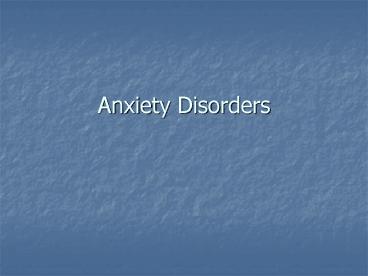Anxiety Disorders - PowerPoint PPT Presentation
1 / 14
Title:
Anxiety Disorders
Description:
Anxiety Disorders Fundamental Features of Anxiety Disorders Fear and Threat Effortful Avoidance Compulsions or Rituals Detachment Experiential Avoidance A person is ... – PowerPoint PPT presentation
Number of Views:1263
Avg rating:3.0/5.0
Title: Anxiety Disorders
1
Anxiety Disorders
2
Fundamental Features of Anxiety Disorders
- Fear and Threat
- Effortful Avoidance
- Compulsions or Rituals
- Detachment
- Experiential Avoidance
- A person is unwilling to remain in contact with
particular private experiences (e.g., bodily
sensations, emotions, thoughts, memories, images,
behavioral predispositions) and takes steps to
alter the form or frequency of these experiences
or the contexts that occasion them, even when
these forms of avoidance cause behavioral harm
3
Multidimensional Construct
- Three Categories
- Subjective Distress (Cognitive Symptoms)
- Worry about specific events harm/danger
- Broader constellation of anxious cognitions
- Physiological Responses
- Sympathetic nervous system
- Tachycardia
- Tremulousness
- Dizziness
- Lightheadedness
- Parathesias
- Dyspnea
- Avoidance or Escape Behaviors
4
Anxiety symptom baserates
- 1/3 of nonclinical populations have had symptoms
of a panic attack at some time in their lifetimes - 90 of nonclinical populations have had obsessive
thoughts no different from OCD
5
Types of Anxiety Disorders
- Panic Disorder (w/o Agoraphobia)
- Agoraphobia without panic
- Social Anxiety Disorder
- Specific Phobia
- Obsessive Compulsive Disorder
- Posttraumatic Stress Disorder
- Acute Stress Disorder
- Generalized Anxiety Disorder
- Other Anxiety Conditions secondary to medical
conditions
6
Medical Conditions and Other Etiologies
- Mitral valve prolapse
- Hypothyroidism
- Cardiovascular problems
- Vestibular abnormalities
- Hyperthyroidism
- Cushings Syndromes
- Alcohol, caffeine, amphetamines, cannabis,
cocaine, hallucinogens, inhalants, phencyclidine,
sedatives, hypnotics, anxiolytics and a host of
medications
7
Comorbidity
- ½ of patients with an anxiety disorder have had
at least one other clinically significant anxiety
or depressive disorder diagnosis - Panic Disorder with Agoraphobia had the highest
comorbidity rates - GAD and Social Phobia had the highest rates as
assignments to other disorders (e.g. depression
or other anxiety disorders)
8
Prevalence
- Anxiety disorders are very prevalent second only
to substance abuse (LT) and highest (past year) - 31 lifetime rate 18.7 past year rate
- Most common are social phobia and specific phobia
- Women experience anxiety dx 2x rate of men
- Exceptions are that social phobia is
disproportionate but not as great - OCD rates are roughly comparable for men and
women
9
Diatheses
- Evidence for heritability for the broad category
of anxiety disorders and - Specific category for panic, agoraphobia, social
phobia and OCD (less evidence for GAD and
specific phobia) - Depression and anxiety may share common genetic
factors - Modest support for genetic markers for AD, better
evidence for genetic marker for temperament
10
Personality
- Children who were more inhibited at earlier ages
evidenced more social inhibition as adults
11
Theories
- Mowers Two Factor Theory
- Exposure Therapy
- Guidelines for Exposure
- Identify the entire stimulus complex (including
verbal processes) - Avoid small exposures that potentiate fear
- Be attuned to escape behavior
- When escape is blocked watch out for
frustration/anger - Reconditioning of fear occurs more rapidly than
the original conditioning
12
Panic Disorder Phenomenology
- Misinterpretation of bodily sensations. Fear of
physical sensations. - A panic attack appears at inappropriate or
unexpected times with no apparent stimulus. - Intense fear and discomfort
- Palpitations
- Smothering
- Dizziness
- Losing Control
- Fear of dying or going crazy
- Peak within 10 minutes often within 1-5 minutes
13
Physiology of Panic
- Panic is an emergency response
- If safe, look for explanation of symptoms
- Sympathetic system either runs its course or the
parasympathetic system takes our and stops the
response - Cardiovascular effects
- Respiratory effects
- Sweat glands
- Effect of overbreathing
14
(No Transcript)































